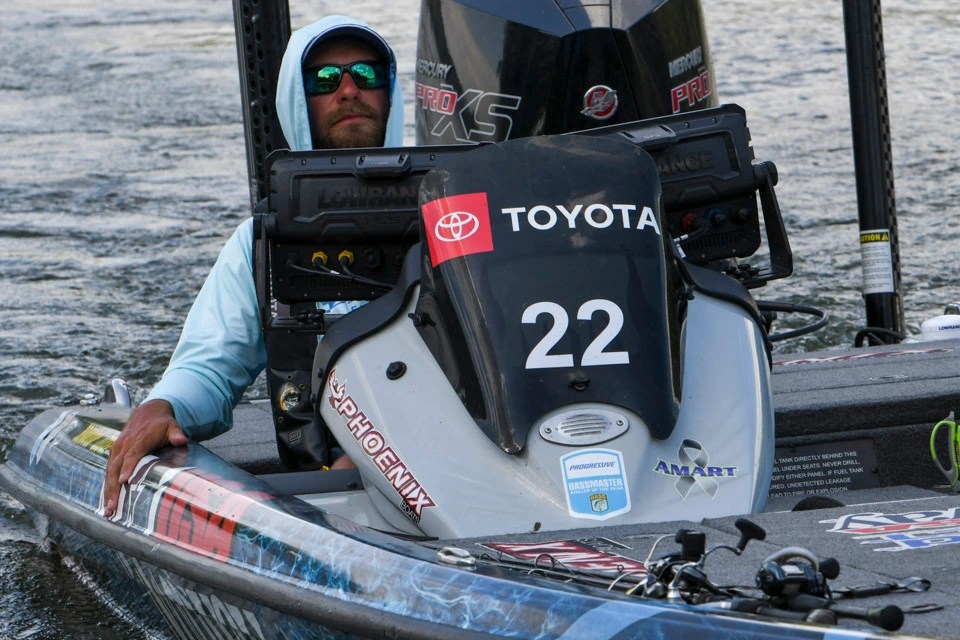
A rare occurrence is unfolding this week at the Whataburger Bassmaster Elite at Pickwick Lake. All indications point to a classic summertime ledge fishing event on the river system where the technique was born.
Specifically, on the portion of the Tennessee River that flows through what is known as the Tennessee Valley, a swath of lowland country in northern Alabama. As the river flows west, the signature ledge impoundments list is legendary. From Lake Guntersville, to Wheeler and Pickwick lakes, the largemouth migrate to the ledges for the summertime.
What makes ledges so productive? The answer is a combination of generated current (here, by the Tennessee Valley Authority), that creates a flow favorable for bass to ambush baitfish as it gets swept past the current breaks where they stage. The water is cooler, the food plentiful, and the bass can move up on top of the ledges.
Bassmaster Elite Series pro Brandon Lester grew up fishing was born, and for that reason, the native Tennessean is among the favorites to perform well this week at Pickwick.
Here is a breakdown of the science of ledge fishing, to help you dial into how it works as you watch the action unfold on Bassmaster LIVE.
Ledges defined
Like the name implies, a ledge is where the bottom forms an edge that drops into the deeper river channel. Bottom structure on the precipitous edge function as a current break, and thusly attract bass. Summertime bass favor ledges for the cooler, flowing water that provides them with food and comfort. Baitfish swept past a key piece of structure are no match for a lurking bass.
All good ledges have the same things in common.
“They have something unique that concentrates the bass in a very small area,” said Lester. “That can be anything that forms that ideal current break.”
Ledges can run for miles, or they can be the termination of an underwater point or sharp flat that ends at the channel.
The perfect ledge
Freshwater muscles that form beds over high spots exposed to the current define that something different in Lester’s world. Such areas define the perfect ledge on the Tennessee River system, and many other similar riverine impoundments across the South.
“Any harder surface standing out from the otherwise softer bottom is the ideal ledge,” he said. “Anywhere else, that could be an isolated rockpile, a hump or even a large tree.”
Lester admitted that dialing into the best ledges, where they run for miles, can be a tedious process. It takes a lot of time with eyes glued to the electronic graph.
“It takes a lot of idling around, marking waypoints, because the best cover is isolated when compared to the surrounding area.”
Those areas also prone to heavy fishing pressure, and in that case, Lester keeps his options open.
“I just expand my search to the immediate area around that best spot,” he said. “When the fish get spooked, they will move off that area, and go somewhere nearby.”
On unfamiliar lakes, or for the inexperienced, Lester recommends starting where ledges are adjacent to major creeks used by the bass throughout the spawning cycle. His reasoning is the bass having only one place to go, which is toward the main lake. The ledges become their summertime home.
Ledge tactics
Lester approaches a waypoint with a watchful eye on the side scan view of his graph to reveal where the bass are concentrated. Once found, he backs of 70 feet from the spot, deploys his trolling motor, and makes long casts to the sweet spot.
“Depths vary by the type of lake and bottom, but a good average depth range is anywhere from 15 to 20 feet,” he said. “Just be mindful that ledge fish get a lot of pressure, so avoid running over the school.”
Lure angles and boat positioning are key. On ledges with current, he keeps the boat downstream. Casts are made above the sweet spot, delivering a natural presentation with the lure coming through or over the muscle bed or bottom cover.
On riverine impoundments throughout the South, the best time to hit the ledges is when power is being generated. The bass are attracted to the current breaks created by the structure, where they wait to ambush passing baitfish.
“Always check the power generation schedule and be on spot when the current starts,” he said. “It’s like flipping a light switch and the bite is on.”
Lures and tips
Lester begins with a deep-diving crankbait. “You will catch the biggest bass, first, and it’s a big bait that can also fire up up the school.” Alternatively, he adds a magnum-style trick or straight tail worm to a 3/4-ounce jighead. “It’s like a magnum shaky head, and you retrieve it Carolina-rig style.” A wacky-rigged drop shot completes the lineup. Lester uses a No. 2 Mustad TitanX Wacky/Neko Rig Hook, 6-inch worm, and 3/8-ounce weight. Cast it to the sweet spot and use a slow pump and drop retrieve.





